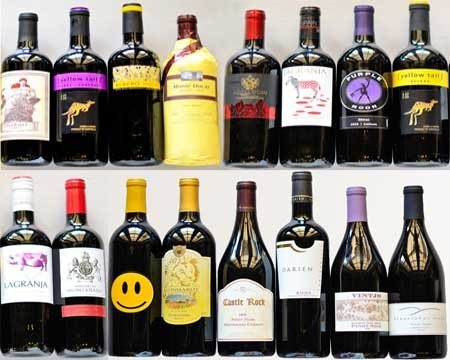The Dueling Inexpensive Red Wine Line-Ups
I have always been curious. In all of my endeavors, I have referred to this trait as "turning over rocks." You have to turn over rocks to see what is underneath. That takes some effort. Many people do not care. But for those that do, there is no assurance of what you will find. Maybe it will be a gold nugget or maybe it will be a rattle snake! Or, even more likely, it will be something in between. So it is with wine. In order to learn about wine, you have to taste new wines. You need to be adventuresome and try new things. In over 40 years of drinking and writing about wine I am still curious and still learning.
So it is that I finally succumbed to the widely advertised Wall Street Journal wine offer. Maybe you have seen it? It is called the Discovery Club WSJwine. You can order an introductory case of red wines, white wines, or a mixed case of red and whites. They cost the same — $69.99 plus $19.99 shipping and tax for a total of $89.98. This works out to about $7.50 per bottle. After the introductory case the price jumps to $139.99 plus $19.99 shipping and tax or $159.98. This works out to just over $13.00 per bottle. I ordered the introductory case of 12 red wines which consisted of eight different wines — one bottle of four wines and two bottles of the other four wines.
And, being even more curious, and having a particular fetish for turning over rocks among other things, I decided to buy some inexpensive wines using approximately the same budget. I chose two different national retailers who carry a large selection of wines at very good prices, Trader Joe's and Costco. I have been buying from both of them since the 1970s. (However, you could also do the same exercise by selecting wines from a local retailer if you have one that has a large selection of wines in the $10 range.) The goal was twofold. First, to see if there were any advantages to buying a pre-selected variety from the Discovery Club WSJwine versus buying wines yourself. Second, I wanted to see what could be found in the lower price ranges.
After all, we are in a time of over-supply for wine. That translates into some really good bargains for wine drinkers who drink wines as opposed those who collect big number trophy wines. Besides the price and quantity (at least as many different wines for approximately the same total price as the Discovery Club WSJwine), my criteria for selecting wines to buy was based again on two factors. First, I wanted wine that I had never tasted before. That would coincide with the wines from the Discovery Club WSJwine which were all new to me. Second, based on my personal taste, I eliminated anything I thought would be an alcoholic fruit bomb (arbitrarily selecting 15% alcohol as a cut-off which also coincided with the wines from the Discovery Club WSJwine where there were no wines over 15%) because I mostly do not like this style of wine.
All of the wines reviewed here were tasted and evaluated over a period of several weeks. Individual wines were tasted over a period of 2-4 days. They were tasted alone, in comparison with other wines, and with and without food. This is, in my opinion, the only way to taste finished wine (that is wine that is bottled and offered for sale). I think the "Drive By Sip And Spit" evaluation of 100-200 wines at a time by some of the big numbers boys is simply an absurdity that has no value no matter what the number (see Underground Wine Line "It's The Ol' Drive By Sip and Spit" October 15, 2010).
So here it is, the dueling inexpensive wine tastings, a three-way shoot out: Discovery Club WSJwine vs. Underground Club JTwine from Trader Joe's vs. Underground Club JTwine from Costco. Let the games begin!
—John Tilson
